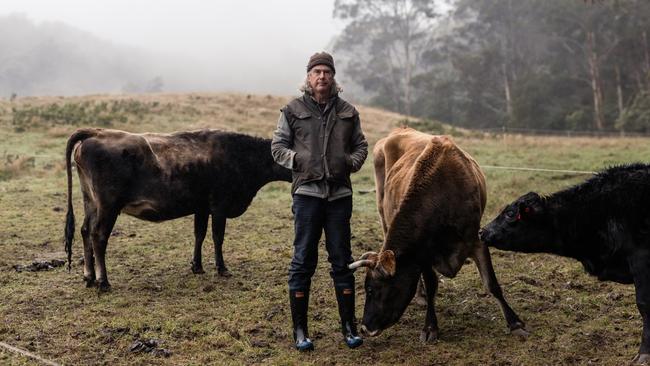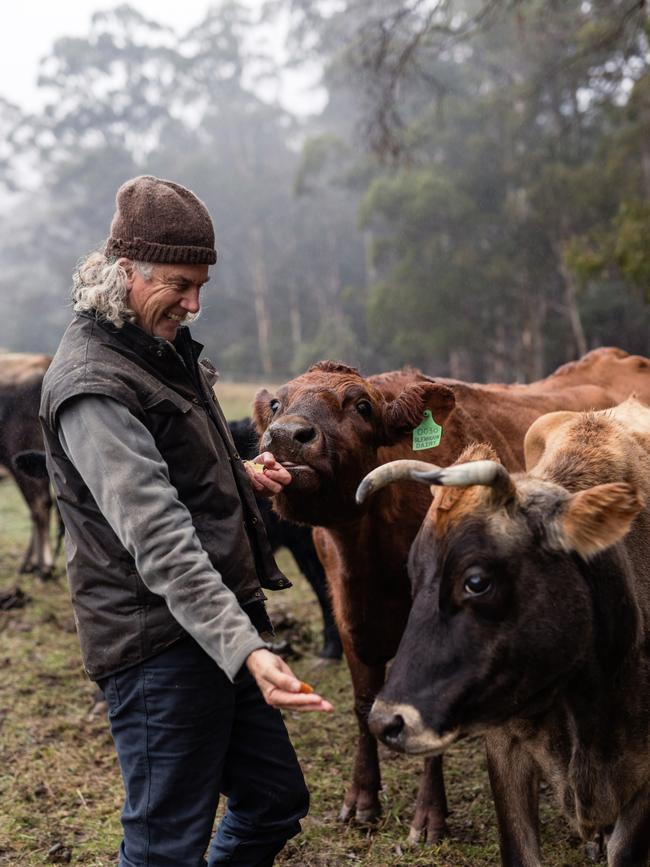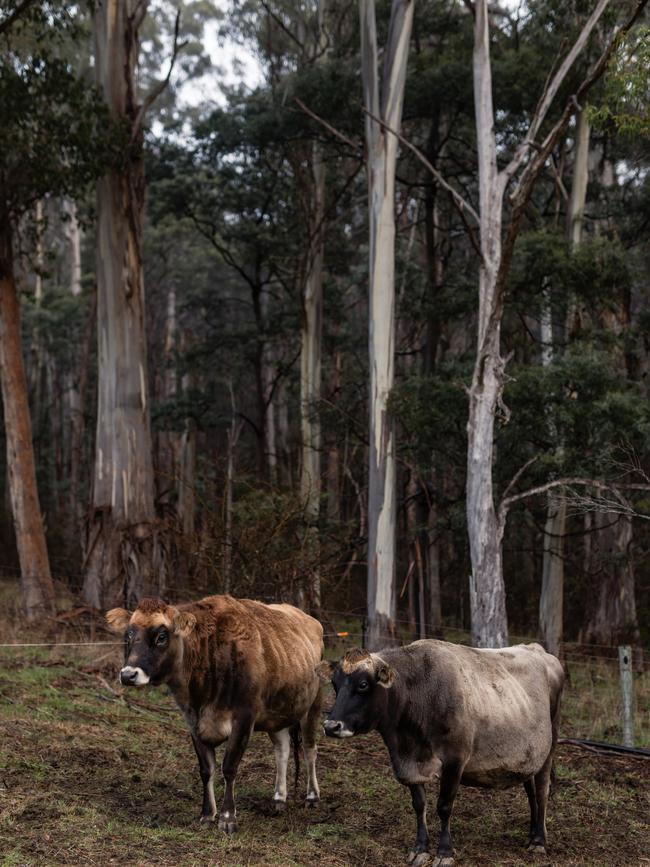The great myth of alternative milks - debunked
On his mission to return dairy milk to its former glory, Matthew Evans says plant-based alternatives aren’t as planet-friendly as you think they are.

Thick, rich, custard-textured raw cream. That’s what I’m scooping out with my ladle. The milk churn sits on the bench. It holds 10 litres (or 2 gallons) of luscious, golden-tinged milk. I enticed it from Myrtle, my Jersey cow, at dawn yesterday and rested it in the fridge overnight. The oozy cream that has risen to the surface is easily plucked off the top with the lazy swirl of a ladle and the judicious use of a spatula. I hold in my hand the fat of the land. Yesterday I used a litre of this milk to make yoghurt. I heated it in a pan until soft cappuccino-like bubbles appeared at the edges, and then I stirred it often as it sat, just below a simmer, for a quarter of an hour. Long, slow heat changes the milk, making my yoghurt thicker, richer, more densely textured, and hence fuller flavoured.
Today, I want to use this yoghurt to culture an overabundance of cream. I add a tablespoon of yesterday’s yoghurt to the cream, whisk briefly, then pour it into a jar to ferment for the next few hours. I’m making soured cream, or crème fraîche in French. It could find a use on tacos, in cake, on baked potatoes … but this batch I’ll clot. Once soured, it’ll be gently heated in a wide tray in a low oven until it sets and has a crust on top. Clotted cream is a thing of beauty – the combination of one of nature’s gifts (cream), controlled rot (bacteria and yeasts) and human ingenuity (heat). Cracking through the caramelised skin to the dreamy sunset-yellow mousse below is one of the joys of milking a cow and being a cook. This concoction will grace my porridge, my scones. I might even make a batch of ice cream from it.
Three days ago, this cream was grass. And that blows my mind. In a day’s time, the milk underneath the cream, which still holds quite a bit of the fat thanks to my low-tech skimming, will be feta cheese. A tablespoon of the whey drained from that cheesemaking will be used to speed up the ferment of my sourdough bread. The rest of the whey will be used to make ricotta. Meanwhile, today’s milk will be skimmed tomorrow to make butter, which will be used to shamelessly slather that bread.
Welcome to the miracle of dairy.
I know not everyone loves milk as I do. Some can’t drink milk. Won’t drink milk. Don’t drink milk for physical or religious or philosophical reasons. And that’s fine, as adults. It’s believed three-quarters of the world’s people get a substantial nutritional benefit from the milk of species not our own. This can seem odd at a time when we’re told that cows are causing climate change, that we don’t need a diet containing animal products to have complete nutrition, and that plant-based eating has the lowest footprint on Mother Earth. With so many new “milks” appearing on the market, my aim is to unpick what is good, and bad, and perhaps not yet widely known, about drinking the milk from humans and other animals.

“It’s more than four times as nutritious as cow’s milk,” exclaimed the scientists, talking about research on a new food source. Cockroaches, it turns out, secrete a milk-like substance to feed their young, according to the story headlined “Scientists think cockroach milk could be the next superfood” which appeared a few years back on the online platform Science Alert.
If your definition of milk is something like “a nutrient-dense substance secreted by the parent to feed its newborn”, cockroach milk fits the bill. The milk crystals that the cockroaches produce are really protein dense, and they also contain fats and sugars, just like dairy. Scientists are trying to work out how to harvest this cockroach “milk”. Unsurprisingly, it’s not by attaching tiny little milking machines to the insects, but by using genetic modification to insert cockroach genes into yeasts that can then be bred up to make the “milk” in a lab. This kind of science reminds me of a wonderful story by John Kennedy, a British climate scientist, who posted on what was once called Twitter: “When an article says ‘some scientists think’, remember this: I, a scientist, once thought I could fit a whole orange in my mouth. I could, it turns out, get it in there, but I hadn’t given sufficient thought to the reverse operation.”
This makes me laugh. As the son of a research chemist who thought science could solve all of humanity’s ills, I can picture this happening. We don’t ever quite seem to be able to predict the consequences of our actions. The thing is, all milk – plant, animal and lab-made – comes with a consequence or three. Sometimes when you hear about agriculture, particularly animal agriculture, the numbers seem scary. The land use, the water use, the greenhouse gases. But we still need to eat, so if milk is to be replaced in part, or in whole, by alternatives, then we need to consider what that means in the whole system, not just at the factory floor.
What happens to the dead yeast, for instance, when you scale up cockroach milk to industrial levels? Anything in quantity is problematic to dispose of. For the past few hundred years, humanity’s solution to pollution has been dilution. Let fresh water flush underneath a salmon farm to help dilute the high nutrient load from their poo. Flush a cannery’s waste down a river. Throw food waste in a tip with all our plastic rubbish, cover it with dirt and walk away, fingers crossed. Or just spread the waste around and hope nature will fix it. But those days are coming to an end. Along with waste, there are other consequences. Making lab-based milk is energy intensive. The yeasts need to be bred up at a certain temperature, and then they need to be dried, which consumes vast amounts of electricity. Is it renewable energy or not? The yeasts also need to be fed something. Is it nitrogen captured using fossil fuels? Is it palm oil? They need water, too. They need equipment. The factories need to use land and resources and human labour. And there’s the waste. Always there’s waste. While the data on the first few of these issues is still sparse, we’ve been dealing with waste from plant-based milks for a while now, and it throws up some interesting conundrums.
Take oat milk, for instance. For every litre of oat milk you drink, there’s about 200g of oat residue – oats that still have much of their fibre and some protein in them. That’s an awful lot of oat pulp kicking around. Numbers for global oat milk production are tricky to find, as most companies keep them close to their chests, but it’s been estimated that it could be as high as 2 billion litres. That would mean there’s about 400 million tonnes of oat pulp to deal with every year. The Sweden-based firm Oatly knows waste oats are a problem. They also know their big vegan audience became very upset when they found out where all that waste was going – namely, into pigs. But at least they’re very open about how they’re trying to deal with oat waste.
Turning the oat residue into food for humans would be the most sustainable alternative, followed by animal feed, biogas and soil improvement.
They say over half of their 41,000 tonnes or so of annual waste goes to energy use, being used to make biogas, while 37 per cent is fed to animals, according to data from 2021. And when they say animals, those are mostly pigs. If you’re vegan and you think that’s bad, by the time they put out their 2022 report, only 31 percent of waste was used for energy – and 59 per cent (more than 49,000 tonnes) was fed to pigs. Oatly’s predicament is not unusual; waste is an eternal dilemma for food producers. What to do with the part of our crops that humans can’t, don’t, or won’t eat?
Traditionally, since agriculture started about 10,000 years ago, we’ve fed those wastes to animals, then milked or eaten the animals. It’s called upcycling, and is often the most energy-efficient and sensible use of a resource. When I asked several other oat milk companies what they do with their oat waste, some, like Germany’s Blue Farm, said they feed it to pigs. Companies such as Rebel Kitchen, which ships its “mylk” products all the way from the UK to Australia, and big player Bonsoy, said nothing. No response. Which says it all, probably.


Just about all plant milks end up with the same problem: a byproduct that nobody wants to eat, or can’t eat. One of these waste products has such a long history, it even has its own moniker. Okara is the name given to the soy pulp that is left over after making soy milk. It contains little digestible sugar and is mostly fibre – namely cellulose, hemicellulose and lignin, which are virtually indigestible. As with oat milk, for every litre of soy milk made, you end up with about 200g of waste – so 20 per cent by weight. There’s some goodness in that residue, though it can be hard to extract. Okara has a pretty high protein component at about 25 per cent, and it still contains 10-15 per cent oil.
So how much okara does the world produce? In China, they are left with 2.8 million tonnes of okara a year. And that’s only a fraction of the world’s output, which comes in at a staggering 1.4 billion tonnes per year. Much of this is fed to animals. Some is thrown away. All of this waste can be dried, to store and transport it better. It can be processed into other foods for people – but currently not much is. Oatly is spot on: the best use of this waste is to find a human food to put it in. But that food will, of course, also be ultra-processed. You’d be hard-pressed to find nice home cooks willing to take some of that 1.4 billion tonnes of okara a year. Where this waste will end up is in factories. That could be why so many of the world’s biggest food ultra-processors are getting into the plant milk game. More feedstock from a new source.
The second most efficient use of this waste from plant milks, after feeding it to humans, is to feed it to livestock. About 85 per cent of what is fed to livestock (when the animals aren’t ranging on grass) is unsuitable for human consumption – think straw from barley, spent grain from brewing, that kind of thing. Plant milk residue is usually ideal, because it contains relatively little fast-digesting sugar (which is bad for ruminants), but still contains fibre and protein that, depending on the ratios, some ruminants – and all pigs – thrive on. So, oats and soy are big producers of waste.
Animal agriculture is agriculture. It sits at the nexus of soil, plant and human ecology. Using animals to consume biomass is a good way to upcycle nutrients. I’m not saying it’s the only way, but it’s one way. And you’d have to be an idiot, and want to insult Mother Earth, to not use her resources wisely. Sitting in a café in Greenwich or Melbourne or Toronto, it may seem weird that the plant milk in your coffee supports animal agriculture further down the chain, but ecological necessity and financial practicality (and those on the ground actually growing your food) show that is the case. Already, some estimate that 38 per cent of American-grown grains go to landfill. If it’s in landfill, it creates methane.
There are, however, clever people coming up with other ways to reduce or use the waste. At least one company, Willa’s in the US, has worked out how to use more complex enzymes to help ensure that most of the whole oat is used in their oat milk. This seems very wise to me. Virtually no waste, and all the nutrition going to the drinker. Other companies are drying the residues – a process that is energy intensive, so only good if the electricity used is renewable. Elajo, a processing company in Sweden, is working on the technology to produce dried oatmeal for use in commercial food production. They’re also looking at extracting the protein to use in meat substitutes, though that is still in the lab stage. Dried pulp can be used in the industrial food system, though again, much ends up in the mouths of animals. Some companies, like Califia Farms, well known for almond milk in the US, send their pulp to a waste contractor that makes slurry. This ends up on soil, so it’s not a bad end, but it’d be so much better if it was further up the food chain.
Animal proponents often say it’s not the cow, it’s the how – meaning it’s not the animal, it’s the way it’s farmed and the way its product is treated. But in fact, it’s not the oat or the almond or the cow. It’s the how. Comparisons are really hard to make to say one thing is saintly, the other not. Oat milk, for instance, is responsible for about 50 times more phosphorus use than goat’s milk, thanks to fertiliser use. One almond milk takes 24 times more energy to produce than another. And one system for producing real dairy milk can use up to 13 times more energy than another. While it’s relatively easy to find numbers on dairy cows and their emissions and waste, little is actually known about the broader impact of new milks. There’s been very few life-cycle assessments done on cashew, coconut, hazelnut, hemp, peanut, quinoa, sesame, tiger nut and walnut milks.


Fake milk is sucking a lot of money out of improving agriculture while we work out if cell factories and plant milks can actually be scaled up sustainably. And in the meantime, some plant milk isn’t popular enough to make it profitable. Much is doing well only because of investors hoping to cash in. Oatly, the world’s biggest oat milk player, saw its share price drop 90 per cent at one point in 2022. In 2023, its sales were up 12 per cent, while at the same time losses were up 87 per cent, with the company losing a third of a billion dollars in a year. For every $1 of oat milk it sells, it spends $1.48.
Will fake milk, after the initial disruption thanks to media hype and plenty of advertising spend, eventually plateau? There’s an old saying in farming: it’s hard to be green when you’re in the red. Oatly seems to be trying to be green while haemorrhaging money. That’s how big business works when there’s cheap money flowing in from speculators, but is it how we feed the world? I think fake milk’s problem isn’t what it is, but what it’s trying to be. Because while plant and cell factory milk are pretending to be milk – hence the addition of vegetable fats and emulsifiers and calcium and more – they aren’t milk in very fundamental ways.

Dairy does have an impact. It varies hugely from place to place, from farm to farm. But it’s not inherently evil, in the same way growing oats isn’t inherently evil – although it must also be said that growing oats usually depletes soil fertility, burns fossil fuels, uses arable land that could be used for other crops, is often a monoculture – and just before harvesting, the oats are often desiccated with glyphosate, the chemical used in Roundup. (If you want to avoid glyphosate, best to get organic oats, which can have 1/40th of the chemical residue of conventional oats.)
All things have consequences. Ditching dairy could well prove to be a bad idea. Certainly, if it’s replaced by ultra-processed foods grown in monocultures that require laboratories and factories in an effort to mimic natural nutrition, then it could be a really dumb idea. You can make your own mind up about what you want to eat – just base it on sound facts, or admit you just feel better one way or the other and don’t care about the numbers. Or only care about the cows. It makes no difference to me if you drink milk or eat dairy or not. If you’re old enough to read this, then you’re adult enough to make your own food choices, and some people will have a belief system that an old white bloke like me is unlikely to change anytime soon. But take it from someone who grows fruit, vegetables and nuts, as well as milks a cow – and has read everything they could muster on the issue – that dairy animals aren’t the worst thing that can happen to the land or the plane.
Text from Milk: The Truth, The Lies, And The Unbelievable Story of The Original Superfood by Matthew Evans. Murdoch Books.





To join the conversation, please log in. Don't have an account? Register
Join the conversation, you are commenting as Logout